Caryn’s Thoughts
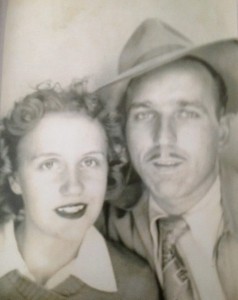
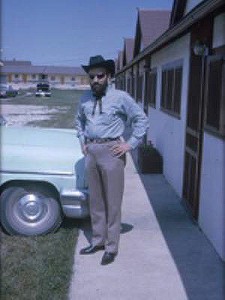 This is a day that I have been particularly dreading since my dad, Allen Spencer passed away on December 12, 2007. The ten year anniversary of his graduation to Heaven. For him, of course, it was a day of great celebration, but for my mom, Collene Spencer…now in Heaven herself, my sisters, Cheryl Masterson, Caryl Reed, Alena Stevens, Allyn Hadlock, and me the day was anything but a celebration. And, their were so many others who felt his passing deeply too…grandchildren, great grandchildren, siblings, siblings-in-law, and friends. It was a day that we somehow thought would never come, and when it did, we were really not at all ready for it, but then are you ever ready for a loved one’s passing? Of course not…we can’t possibly prepare.
This is a day that I have been particularly dreading since my dad, Allen Spencer passed away on December 12, 2007. The ten year anniversary of his graduation to Heaven. For him, of course, it was a day of great celebration, but for my mom, Collene Spencer…now in Heaven herself, my sisters, Cheryl Masterson, Caryl Reed, Alena Stevens, Allyn Hadlock, and me the day was anything but a celebration. And, their were so many others who felt his passing deeply too…grandchildren, great grandchildren, siblings, siblings-in-law, and friends. It was a day that we somehow thought would never come, and when it did, we were really not at all ready for it, but then are you ever ready for a loved one’s passing? Of course not…we can’t possibly prepare.
With each year thereafter, the sting of his passing remained, although we got used to feeling it, but the ten year mark has been one that seemed so incredibly impossible, that I continued to push it to the back of my 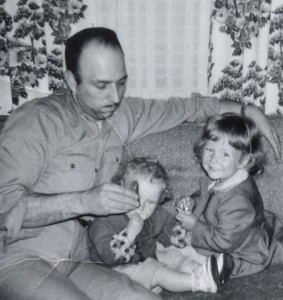
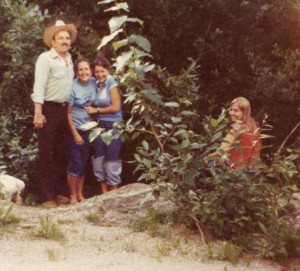 mind. It ranked right up there with the thought of living even one day on this earth without my parents. It lived in the realm of the impossible, and now it is simply reality. We go through our days in a state of acceptance, because there is nothing else we can do…we have no other choice.
mind. It ranked right up there with the thought of living even one day on this earth without my parents. It lived in the realm of the impossible, and now it is simply reality. We go through our days in a state of acceptance, because there is nothing else we can do…we have no other choice.
Our dad was a wonderful, sweet, kind, and loving man, who treated our mom like a queen and his daughters like princesses. We never doubted his love for any of us. We may not have had riches or a castle, but there are better ways to be treated like royalty. We just always knew that we were loved. We didn’t need riches or castles, because we had quality time with our parents. We got to travel the United States, and took trips every summer. We learned to read maps, build campfires, see so many wonderful places, 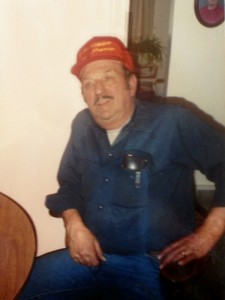
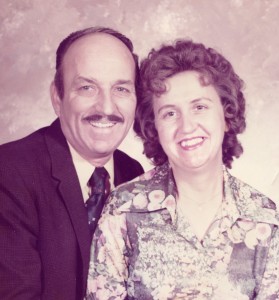 and enjoy each others company. It made us a very close family, and that closeness continues to this day. My family was so blessed to have such a man as our dad, and so when he left us…the void was huge!! And now to think that he has been in Heaven for ten long years…well, it makes me feel very sad and lonely. My only consolation is that I know that now my dad…and my mom too…is in my future, not in my past. For me, it just feels like the future is so very far away. I would love to have a hug from my dad right now, not years down the road, and I would love to hear his voice again, and not only in my memory. I just can’t believe that he could have been gone that long. I love and miss you Dad…so very much.
and enjoy each others company. It made us a very close family, and that closeness continues to this day. My family was so blessed to have such a man as our dad, and so when he left us…the void was huge!! And now to think that he has been in Heaven for ten long years…well, it makes me feel very sad and lonely. My only consolation is that I know that now my dad…and my mom too…is in my future, not in my past. For me, it just feels like the future is so very far away. I would love to have a hug from my dad right now, not years down the road, and I would love to hear his voice again, and not only in my memory. I just can’t believe that he could have been gone that long. I love and miss you Dad…so very much.

 This year has been a little difficult for my nephew, Barry Schulenberg and his wife, Kelli. Their long-time companion, Dakota, a Black Labrador Retriever dog passed away a few months ago, and they were feeling very sad. Anytime you lose a pet, there is period of time that must pass before you feel ready to have another pet. It’s different for everyone. Dakota went everywhere with Barry and Kelli. He was their hiking and camping companion….always happy to be right there beside them. Dakota was always waiting at the door to greet them when they got home from work. Dakota was like their child, and he had been with them all of their married life. It’s hard to imagine life without your pet, because the reality is that your pet is a part of the family…a big part of your family.
This year has been a little difficult for my nephew, Barry Schulenberg and his wife, Kelli. Their long-time companion, Dakota, a Black Labrador Retriever dog passed away a few months ago, and they were feeling very sad. Anytime you lose a pet, there is period of time that must pass before you feel ready to have another pet. It’s different for everyone. Dakota went everywhere with Barry and Kelli. He was their hiking and camping companion….always happy to be right there beside them. Dakota was always waiting at the door to greet them when they got home from work. Dakota was like their child, and he had been with them all of their married life. It’s hard to imagine life without your pet, because the reality is that your pet is a part of the family…a big part of your family.
After that kind of loss, there is always a grieving period, before you can possibly move on and find another dog to adopt into the family. Barry and Kelli took their time. healing at their own pace. They did the normal things they like to do…camping, hiking, target practice, and just spending quiet nights at home. Soon though, it became clear to them, that something was missing. It was time to fill the void left behind with Dakota’s passing. That is a big step for any pet owner. It’s hard to open your heart to another pet, after losing one that was such a big part of your life for so many years. So, after some soul searching, Barry and Kelli decided to take to plunge, and adopt again.
They went to see what was available, and came up with a male Border Collie/Australian Cattle Dog mix. For a while, their new “baby” didn’t have a name. They wanted to see what name might fit him. Before long, the puppy became a Scout. He always seemed to be at the alert, as if scouting his next move. Barry and Scout 
 became inseparable. Scout loves to hang out with Barry, hoping to receive the scratching and petting that all dogs crave. Scout even loves riding around on the 4-wheeler with Barry. They say that a dog is man’s best friend, and Scout is definitely Barry’s best friend…with the exception of Kelli, of course. I know that this is the beginning of a beautiful friendship for Barry, Kelli, and Scout, and I think Dakota would be happy too. Today is Barry’s birthday. Happy birthday Barry!! Have a great day!! We love you!!
became inseparable. Scout loves to hang out with Barry, hoping to receive the scratching and petting that all dogs crave. Scout even loves riding around on the 4-wheeler with Barry. They say that a dog is man’s best friend, and Scout is definitely Barry’s best friend…with the exception of Kelli, of course. I know that this is the beginning of a beautiful friendship for Barry, Kelli, and Scout, and I think Dakota would be happy too. Today is Barry’s birthday. Happy birthday Barry!! Have a great day!! We love you!!


 For most people the holidays are all about tradition. Of course, for all Christians, Christmas is about Jesus, but it’s also about family time, family traditions, parties, and gifts…with the greatest gift being Jesus. But, one tradition concerning those parties, for me and my family anyway, is the traditional Byer Family Christmas party. My mom, Collene Byer Spencer’s parents George and Hattie Byer started the tradition years and years ago, when their house really got too small to handle their large and ever growing family. The party was moved to the Mills Fire Hall, and on the day of the party, we literally filled it up!! Grandma and Grandpa Byer were surrounded by their loving children, grandchildren, and great grandchildren…and they were so happy. With a family as large as ours, well over 300 now, of course, you might not get to talk with each and every one, but you saw them, and they saw you, and it kept the family close. Grandma and Grandpa wanted that tradition to continue, even after their passing, and so they charged their children with the task of keeping the tradition alive, and the family close. And they did a good job of it.
For most people the holidays are all about tradition. Of course, for all Christians, Christmas is about Jesus, but it’s also about family time, family traditions, parties, and gifts…with the greatest gift being Jesus. But, one tradition concerning those parties, for me and my family anyway, is the traditional Byer Family Christmas party. My mom, Collene Byer Spencer’s parents George and Hattie Byer started the tradition years and years ago, when their house really got too small to handle their large and ever growing family. The party was moved to the Mills Fire Hall, and on the day of the party, we literally filled it up!! Grandma and Grandpa Byer were surrounded by their loving children, grandchildren, and great grandchildren…and they were so happy. With a family as large as ours, well over 300 now, of course, you might not get to talk with each and every one, but you saw them, and they saw you, and it kept the family close. Grandma and Grandpa wanted that tradition to continue, even after their passing, and so they charged their children with the task of keeping the tradition alive, and the family close. And they did a good job of it.
Now, there are several of those kids who have, themselves, gone on to Heaven, and sadly, our numbers are 

 dwindling, because we…the grandchildren have failed to take the reigns, and keep Grandma and Grandpa Byer’s dream alive. It is so easy to look at the aunts and assume that this is their duty, and not ours, but is it…really? Aren’t we, the grandchildren old enough now to also take up the simple task and honor our grandparents, and our aunts and uncles, in such a way. There are, of course, a number of the grandchildren who still come to the party every year, and we find ourselves very blessed by the evening. It is fun, and if we take a few minutes to walk around the room and visit with our aunts, uncles and cousins, we will find that we have a pretty wonderful family, and that the traditional Byer Family Christmas Party is a blessing that continues to grow…needing really just the watering of more loved ones to join in. It saddens me to think that the day might come, when it no longer makes sense to rent the facilities, because so few have shown up in past years, but it could come to that I suppose. We all think there is a lot of time to visit with our aunts, uncles, and cousins, but every time one of them goes to Heaven, we find out that there was so little time, and we wasted it, by thinking that our presence didn’t really matter. They could do without us. And yes, the party did go on, and we all had a great time, but the family members who were not there…who could have been, because they
dwindling, because we…the grandchildren have failed to take the reigns, and keep Grandma and Grandpa Byer’s dream alive. It is so easy to look at the aunts and assume that this is their duty, and not ours, but is it…really? Aren’t we, the grandchildren old enough now to also take up the simple task and honor our grandparents, and our aunts and uncles, in such a way. There are, of course, a number of the grandchildren who still come to the party every year, and we find ourselves very blessed by the evening. It is fun, and if we take a few minutes to walk around the room and visit with our aunts, uncles and cousins, we will find that we have a pretty wonderful family, and that the traditional Byer Family Christmas Party is a blessing that continues to grow…needing really just the watering of more loved ones to join in. It saddens me to think that the day might come, when it no longer makes sense to rent the facilities, because so few have shown up in past years, but it could come to that I suppose. We all think there is a lot of time to visit with our aunts, uncles, and cousins, but every time one of them goes to Heaven, we find out that there was so little time, and we wasted it, by thinking that our presence didn’t really matter. They could do without us. And yes, the party did go on, and we all had a great time, but the family members who were not there…who could have been, because they 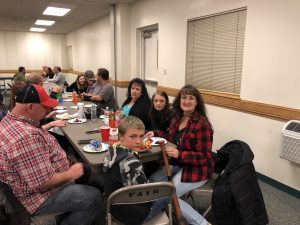

 didn’t have to work, or have anyplace else to be, the ones who simply stayed at home…believe me…yes, you were missed, very much.
didn’t have to work, or have anyplace else to be, the ones who simply stayed at home…believe me…yes, you were missed, very much.
Grandma Byer was a great cook, and she taught her children well, and they taught their children well, and I can tell you that we are a family of great cooks. The food last night was delicious, everyone enjoyed it very much. The children were able to run and play without being in the way, and their parents could relax, because no one was going to think they should make their children sit still. The party is one where everyone’s feeling are treated with care, and oh my…did the children have a great time. No one got hurt, and they got to get their wiggles out, and probably eat far too many sweets, but hey, what is a party for anyway? I loved seeing all the precious little ones, whose eyes danced with glee as they got to spend time with other children that they hadn’t seen in quite a while, and as you know, kids don’t need an introduction. The see another kid their size, and it’s an instant friendship. Oh, that we adults could make friends so easily. All too soon, the party was over, and for many of us, it will be the last time we will see each other until the summer picnic…the other family tradition. 

 We all lead busy lives, and daily visits are hard, but Grandma and Grandpa Byer wanted us to continue the tradition. So to all of you who came, thank you. It was great to see you and I really enjoyed our time together. And to all who couldn’t be there, know that you were missed. Merry Christmas to all of you.
We all lead busy lives, and daily visits are hard, but Grandma and Grandpa Byer wanted us to continue the tradition. So to all of you who came, thank you. It was great to see you and I really enjoyed our time together. And to all who couldn’t be there, know that you were missed. Merry Christmas to all of you.
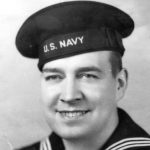 When we think of the name Hitler, most of us think of the vicious dictator who was responsible for the slaughter of as many a 6 million Jewish people, not to mention all the other people he killed in his crazed state of mind. For most of us, hearing the name Hitler brings with it feelings of horror, disgust, and continued shock every time we learn a new fact about Hitler and his Third Reich. Yes, the name Hitler doesn’t usually bring any feelings of…anything good. Well, what I learned today, changed my view of that. You see, not everyone named Hitler was evil, not even everyone named Hitler during World War II, and not even everyone who had the unfortunate…misfortune of being related to Adolf Hitler. You see, for William Patrick Hitler of Liverpool, England, having the name wasn’t the worst part of his situation. William was actually the nephew of Adolf Hitler, the Führer of Nazi Germany. It was a reality that made him almost nauseous. Dealing with that reality would take William on a zigzag path leading to Germany, England, America, and finally the United States Navy. I’m sure that you, like me, thought, “How could the United States Navy allow a nephew of Adolf Hitler to join up, much less to muster out with men sent to fight his uncle.
When we think of the name Hitler, most of us think of the vicious dictator who was responsible for the slaughter of as many a 6 million Jewish people, not to mention all the other people he killed in his crazed state of mind. For most of us, hearing the name Hitler brings with it feelings of horror, disgust, and continued shock every time we learn a new fact about Hitler and his Third Reich. Yes, the name Hitler doesn’t usually bring any feelings of…anything good. Well, what I learned today, changed my view of that. You see, not everyone named Hitler was evil, not even everyone named Hitler during World War II, and not even everyone who had the unfortunate…misfortune of being related to Adolf Hitler. You see, for William Patrick Hitler of Liverpool, England, having the name wasn’t the worst part of his situation. William was actually the nephew of Adolf Hitler, the Führer of Nazi Germany. It was a reality that made him almost nauseous. Dealing with that reality would take William on a zigzag path leading to Germany, England, America, and finally the United States Navy. I’m sure that you, like me, thought, “How could the United States Navy allow a nephew of Adolf Hitler to join up, much less to muster out with men sent to fight his uncle.
Born March 12, 1911, in Liverpool, England, William Hitler was the only child of Bridget Dowling and her Austrian expatriate husband, Alois Hitler Jr, who was the half-brother of Adolf Hitler. In 1914, Alois abandoned his wife and three year old son to go traveling through Europe. The outbreak of World War I prevented him from returning to England, so he settled down in Germany, married again, despite still being married to Dowling, and started a new family. For years, Alois made no attempt to contact his wife and son back in Liverpool, but rather had someone tell Dowling that he was dead. In 1924, the truth came out. Alois was charged with bigamy in Germany, but avoided conviction because Dowling actually interceded on his behalf. That was all she did however. She drew the line, when Alois asked her to send William to Germany for a visit. She told him that she would not let her son visit until he reached his 18th birthday, in 1929. Upon turning 18, William traveled to Germany and reconnected with his father, who took him to a Nazi rally where he saw his Uncle Adolf, leader of the rising National Socialist (Nazi) Party. William visited Germany again in 1930, this time 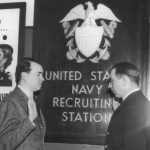 meeting his uncle in person and receiving an autographed photo from him.
meeting his uncle in person and receiving an autographed photo from him.
I’m sure that William thought that his relationship with his uncle would be something that would advance his journalism career, but Hitler didn’t want anyone to know what he was doing. William’s articles about his Uncle Adolf Hitler, only served to be the beginning of being blackballed from everything to do with Adolf Hitler, and his disgust with Adolf Hitler and his insane ways. Hitler called William to Berlin, and reportedly ordered him to retract the articles. Now William saw a totally different side of his uncle…describing it as a “wild-eyed and tearful” outburst. Apparently Hitler even threatened to kill himself if William ever again published anything about his personal life. Now, William became persona non grata in England. He was fired from his job in 1932. Unable to find other employment in his homeland, he decided to look for work in Germany. Perhaps his increasingly influential uncle could be persuaded to help, but no warm welcome awaited in Germany. According to William, whose July 4, 1939 article for Look magazine, “Why I Hate My Uncle,” is the sole source on his dealings with his uncle Adolf Hitler, who sent William a letter during his visit, denying they were relatives. Shortly afterward, William’s father sent him back to England. I guess he was persona non grata with his dad too.
William tried using his relationship to Hitler to obtain a job in Germany, and was successful, but when he tried to send money to his mother, he was informed that Hitler would not allow it…even for family. William began to see a much more evil side of his uncle. Eventually, he left Germany and went back to England, but found that he was not welcome there either. He and his mother moved to the United States, where his relationship again caused him problems. Finally, in 1942, William wrote directly to President Franklin D. Roosevelt, begging to be allowed to serve in the US military. “I am one of many, but can render service to this great cause,” he wrote. FDR passed the letter on to FBI Director J. Edgar Hoover, who looked into William’s background and finally cleared him for military service. Sworn into the US Navy in New York City on March 6, 1944, William Hitler went on to serve three years as a pharmacist’s mate, receiving the Purple Heart for a wound he suffered. He was 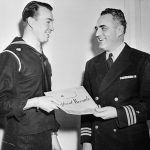 discharged in 1947.
discharged in 1947.
Finally tired of the attention his controversial surname attracted, William changed it to Stuart-Houston after returning to the civilian world. He married German-born Phyllis Jean-Jacques, and the couple settled in Patchogue on New York’s Long Island, where they had four children, the first of whom bore the surprising middle name of Adolf. William ran a blood analysis lab, Brookhaven Laboratories, in his family’s home. William Stuart-Houston died on July 14, 1987, and was buried next to his late mother in Coram, New York. His children did not produce any children of their own…and so ended the line.

 Over the years of her adulthood, my niece, Jessi Sawdon has been an excellent organizer. She worked as a runner for a law office in high school, and the moved on to working as a legal secretary. She was also active in the young professionals association. She was the epitome of a professional career girl. It would have looked to the untrained eye, that Jessi would go far in the corporate world, and maybe even become a lawyer, but those of us who know her well, do not have untrained eyes. While Jessi is a great organizer, a savvy legal secretary, and a great career girl, she also had a greater calling.
Over the years of her adulthood, my niece, Jessi Sawdon has been an excellent organizer. She worked as a runner for a law office in high school, and the moved on to working as a legal secretary. She was also active in the young professionals association. She was the epitome of a professional career girl. It would have looked to the untrained eye, that Jessi would go far in the corporate world, and maybe even become a lawyer, but those of us who know her well, do not have untrained eyes. While Jessi is a great organizer, a savvy legal secretary, and a great career girl, she also had a greater calling.
When Jessi met her future husband, Jason, she was almost complete. Jessi and Jason were perfect for each other from the start. Their personalities, their goals, and their crazy sense of humor, all seemed to line up perfectly. I guess that’s what happens when a match is made in Heaven. Things were changing for Jessi, and at first, it was hard to be sure where all this was heading, but the sure thing was that Jessi’s life, and Jason’s too, for that matter, were never going to be the same. I’m sure they didn’t know where things were headed…at first, but before long, they knew that theirs was a forever kind of love. Jessi and Jason got married on August 18, 2012, and settled into married life. They were parents to their sweet dog, Daisy, and Jessi went back to school. For a while, it looked like the career girl was going to push forward in her career, and maybe even become a lawyer or something.
But, Jessi still had that greater calling…motherhood. On August 25, 2016, their daughter, Adelaide Ione Sawdon came along. Suddenly, both Jessi and Jason knew what their greater calling was!! And with the greater calling…life has changed…forever. Jessi and Jason found out that their greatest calling…parenthood, was like no other calling in the world. Life would get crazy. They would lose sleep…many times, both now and in the future. They would laugh and cry with their little girl, because they would intensely feel every emotion she did. That’s what parents do. Parents feel every scraped knee, every bumped head, every failed attempt to do whatever their child is trying to do, and every victory when they are successful at their ventures. As their child learns the ropes of life, their parents watch, hoping to help their little one avoid as many of life’s pains and hurts as possible, while celebrating every accomplishment that the precious gift, that is their child makes as they go through their life. There is truly no greater calling than that, except the calling to God’s service, of course.

 Jessi’s life has changed in many ways since her marriage and motherhood. In some ways, life has taken on a more relaxed pace, but that doesn’t mean that she is no longer a career girl, she just found an attorney who lets her work from home. That keeps her foot in the door, so that if she wants to go back into a career full time, she could do that later on. Don’t think that a relaxed pace means a slow pace, however, because as any parent knows having a child in the house is anything, but slow paced. Today is Jessi’s birthday. Happy birthday Jessi!! Have a great day!! We love you!!
Jessi’s life has changed in many ways since her marriage and motherhood. In some ways, life has taken on a more relaxed pace, but that doesn’t mean that she is no longer a career girl, she just found an attorney who lets her work from home. That keeps her foot in the door, so that if she wants to go back into a career full time, she could do that later on. Don’t think that a relaxed pace means a slow pace, however, because as any parent knows having a child in the house is anything, but slow paced. Today is Jessi’s birthday. Happy birthday Jessi!! Have a great day!! We love you!!
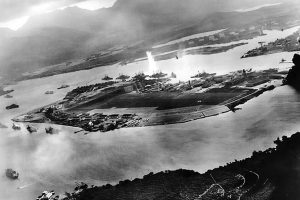
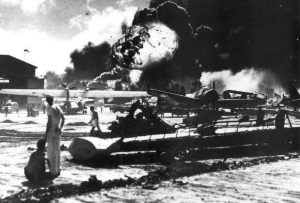 It doesn’t matter how many years have gone by since that horrible December day 76 years ago today, I don’t think that anyone who knows anything about the attack on Pearl Harbor can forget just how horrific it was. I suppose they should have known that an attack was imminent, or at the very least suspected it. Diplomatic negotiations with Japan had broken down, and President Franklin D. Roosevelt and his advisers knew that an imminent Japanese attack was probable. Still, nothing had been done to increase security at the important naval base at Pearl Harbor. It was critical mistake that would cost a total of 2,400 Americans their lives. In addition, 1,200 were wounded, many while valiantly attempting to defend Pearl Harbor from the attack.
It doesn’t matter how many years have gone by since that horrible December day 76 years ago today, I don’t think that anyone who knows anything about the attack on Pearl Harbor can forget just how horrific it was. I suppose they should have known that an attack was imminent, or at the very least suspected it. Diplomatic negotiations with Japan had broken down, and President Franklin D. Roosevelt and his advisers knew that an imminent Japanese attack was probable. Still, nothing had been done to increase security at the important naval base at Pearl Harbor. It was critical mistake that would cost a total of 2,400 Americans their lives. In addition, 1,200 were wounded, many while valiantly attempting to defend Pearl Harbor from the attack.
It was Sunday morning, and many military personnel had been given passes to attend religious services off base. It should have been a quiet, peaceful, relaxing day. At 7:02am, two radar operators spotted large groups of aircraft in flight toward the island from the north. With a flight of B-17s expected from the United States at the time, they were told to sound no alarm. They were told wrong. At 7:55am Hawaii time, the peaceful day was shattered when, a Japanese dive bomber bearing the red symbol of the Rising Sun of Japan on its wings appeared out of the clouds above the island of Oahu. A swarm of 360 Japanese warplanes followed, descending on the United States naval base at Pearl Harbor. It was a ferocious assault. The surprise attack struck a critical blow against the United States Pacific fleet and drew the United States into World War II…like it or not. The Japanese air assault came as a devastating surprise to the naval base. Much of the Pacific fleet was rendered useless. There was simply no time to act. The window of opportunity for them to act was missed when no warning was given. Five of eight battleships, three destroyers, and seven other ships were sunk or severely damaged, and more than 200 aircraft were destroyed. Japan’s losses were some 30 planes, five midget submarines, and fewer than 100 men, and many of these were intentional suicide bombers. Fortunately for the United States, all three Pacific fleet carriers were out at sea on training maneuvers. These giant aircraft carriers would have their revenge against Japan six months later at the Battle of Midway, in a battle that would reverse the tide against the previously invincible Japanese navy in a spectacular victory.
The day after Pearl Harbor was bombed, President Roosevelt appeared before a joint session of Congress and declared, “Yesterday, December 7, 1941…a date which will live in infamy…the United States of America was suddenly and deliberately attacked by naval and air forces of the Empire of Japan.” After a brief and forceful speech, he asked Congress to approve a resolution recognizing the state of war between the United States and Japan. Finally, the president had taken action. The Senate voted for war against Japan by 82 to 0, and the House of Representatives approved the resolution by a vote of 388 to 1. The sole dissenter was Representative Jeannette Rankin of Montana, a devout pacifist who had also cast a dissenting vote against the United States 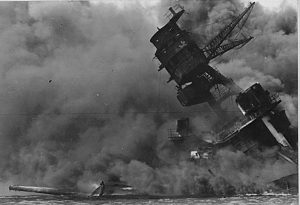
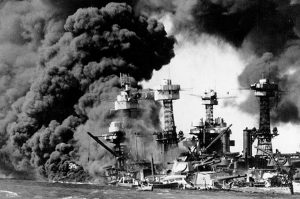 entrance into World War I. Three days later, Germany and Italy declared war against the United States, and the United States government responded in kind. The American contribution to the successful Allied war effort spanned four long years and cost more than 400,000 American lives. The attack on Pearl Harbor was a vicious attack that shows us that in a war, neutrality is not a guarantee of safety, but is rather viewed as a sign of weakness.
entrance into World War I. Three days later, Germany and Italy declared war against the United States, and the United States government responded in kind. The American contribution to the successful Allied war effort spanned four long years and cost more than 400,000 American lives. The attack on Pearl Harbor was a vicious attack that shows us that in a war, neutrality is not a guarantee of safety, but is rather viewed as a sign of weakness.
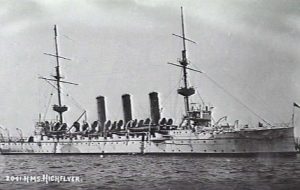
 Any time explosives are being transported, there is danger associated with it. Of course, explosives like nitroglycerine used to be very volatile, and just having the bump around on a dirt road could set it off. Things might be safer now, but the danger still exists. On December 6, 1917, in the harbor outside Halifax, Nova Scotia, Canada, a Belgian steamer and French freighter exploded. Both were loaded with ammunition. The explosion was disastrous. Sixteen hundred people were killed immediately. They were sailors looking on from the decks of their ships, rail-workers, and longshoremen. They were onlookers who were drawn to the spectacle of the burning ship. They were laborers looking on from factory windows or doorways, shopkeepers, and firemen. They were wives, mothers and babies, and school children. Just people going about their daily lives, who were caught up in the shocking scene…and it cost them their lives. Nine thousand more people were wounded. The 8 million tons of TNT carried by the ships was intended for use in World War I. The ships were gathered in Halifax, which was the meeting point for convoys to begin the dangerous Atlantic crossing. They would go together as protection from the German U-Boat submarines. The HMS High Flyer was to be the lead ship in the convoy that trip. The freighter from France, the Mont Blanc, had picked up a full load of TNT in New York and came into the harbor that foggy morning. Due to the poor conditions, it collided with the Imo, a Belgian steam boat, also carrying ammunition. A fire resulted and both ships were abandoned immediately.
Any time explosives are being transported, there is danger associated with it. Of course, explosives like nitroglycerine used to be very volatile, and just having the bump around on a dirt road could set it off. Things might be safer now, but the danger still exists. On December 6, 1917, in the harbor outside Halifax, Nova Scotia, Canada, a Belgian steamer and French freighter exploded. Both were loaded with ammunition. The explosion was disastrous. Sixteen hundred people were killed immediately. They were sailors looking on from the decks of their ships, rail-workers, and longshoremen. They were onlookers who were drawn to the spectacle of the burning ship. They were laborers looking on from factory windows or doorways, shopkeepers, and firemen. They were wives, mothers and babies, and school children. Just people going about their daily lives, who were caught up in the shocking scene…and it cost them their lives. Nine thousand more people were wounded. The 8 million tons of TNT carried by the ships was intended for use in World War I. The ships were gathered in Halifax, which was the meeting point for convoys to begin the dangerous Atlantic crossing. They would go together as protection from the German U-Boat submarines. The HMS High Flyer was to be the lead ship in the convoy that trip. The freighter from France, the Mont Blanc, had picked up a full load of TNT in New York and came into the harbor that foggy morning. Due to the poor conditions, it collided with the Imo, a Belgian steam boat, also carrying ammunition. A fire resulted and both ships were abandoned immediately.
The Stella Maris was moving up to the Mont-Blanc at the time of the explosion. The crew were attempting to attach a line to the Mont Blanc to tow it away from Pier 6. When the Mont-Blanc exploded the Stella Maris was swamped and thrown up onto the shore. Captain Brannen and nineteen of his crew members were killed instantly. By some miracle William Nickerson, the second mate, and four of the crew members survived. At Pier 8, to the 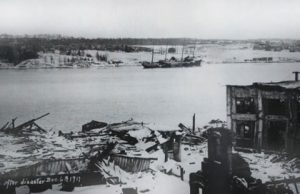
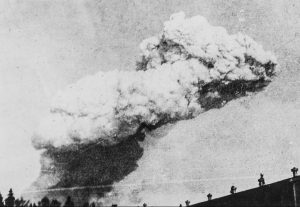 north of Pier 6, stood the steamer Curaca, that had been loading mules. The Curaca was found in the center of Tuft’s Cove, across the harbor, at Dartmouth, with her bow protruding from the water. The stern of the Curaca was pushed in, her masts and smokestack were blown away. Although the Saint Bernard was on the northern side of Pier 6, the pier offered no protection. The Saint Bernard was completely destroyed along with Pier 6 and the Lola R, a small schooner. Here the Saint Bernard was beached at Parsboro, its home port, during winter prior to the explosion. The Picton was tied up at the Sugar Refinery Wharf just below Pier 6. At the time of the explosion the Picton was being unloaded to undergo repairs. Her cargo included munitions. Due to the quick thinking of the longshoremen the hatches were closed. Although the Picton caught fire, it was quickly put out with the help of the crew of the tugboat Lee. A British ship, the Pictou, was at a pier in the harbor and was also filled with ammunition. The crew of the Pictou immediately fled and set the ship free upon witnessing the collision. The High Flyer was the only ship that took any action to try to stop the disaster…it sent 23 men toward the collision to attempt to sink the vessels. They were too late. Just as they reached the burning ships, a massive explosion occurred.
north of Pier 6, stood the steamer Curaca, that had been loading mules. The Curaca was found in the center of Tuft’s Cove, across the harbor, at Dartmouth, with her bow protruding from the water. The stern of the Curaca was pushed in, her masts and smokestack were blown away. Although the Saint Bernard was on the northern side of Pier 6, the pier offered no protection. The Saint Bernard was completely destroyed along with Pier 6 and the Lola R, a small schooner. Here the Saint Bernard was beached at Parsboro, its home port, during winter prior to the explosion. The Picton was tied up at the Sugar Refinery Wharf just below Pier 6. At the time of the explosion the Picton was being unloaded to undergo repairs. Her cargo included munitions. Due to the quick thinking of the longshoremen the hatches were closed. Although the Picton caught fire, it was quickly put out with the help of the crew of the tugboat Lee. A British ship, the Pictou, was at a pier in the harbor and was also filled with ammunition. The crew of the Pictou immediately fled and set the ship free upon witnessing the collision. The High Flyer was the only ship that took any action to try to stop the disaster…it sent 23 men toward the collision to attempt to sink the vessels. They were too late. Just as they reached the burning ships, a massive explosion occurred.
The explosion sent burning debris throughout Halifax. It also caused a large wave to form that pushed the ships at pier right up out of the harbor. A Canadian army officer stationed at Halifax described the result, “All that could be seen for a great circumference were burning buildings, great mounds of iron and brick in the streets and dead bodies.” A 2½ mile radius was completely demolished and the explosion could be felt 125 miles away. The wave of water hit a Navy ammunition plant located near the shores. That water most likely kept it from catching fire. Most other places nearby were not hit with the wave, unfortunately. The railway station collapsed from the blast and crushed scores of people inside. About 100 more were killed in a sugar plant 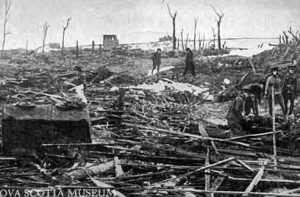
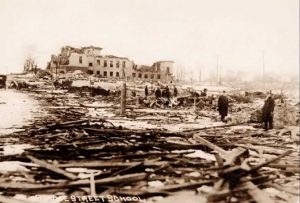 located near the water. Of the 500 students located in schools nearby, less than 10 survived. In all, the death toll was somewhere between 1,200 and 4,000. No one knows for sure because so much of the city was completely obliterated. Many more might have died except for a snowstorm that hit the area later that day. It helped put out the flames, but not before 25,000 people were left homeless in the wake of the disaster.
located near the water. Of the 500 students located in schools nearby, less than 10 survived. In all, the death toll was somewhere between 1,200 and 4,000. No one knows for sure because so much of the city was completely obliterated. Many more might have died except for a snowstorm that hit the area later that day. It helped put out the flames, but not before 25,000 people were left homeless in the wake of the disaster.

 When our girls, Corrie Petersen and Amy Royce were little, we used to go to visit my husband, Bob’s aunt and uncle, Linda and Bobby Cole every year, right before school started. It was the final trip of the summer…Labor Day weekend. Soon after, they would be back in school, and they lazy days of summer would be over. We all looked forward to going, and it was always a lot of fun.
When our girls, Corrie Petersen and Amy Royce were little, we used to go to visit my husband, Bob’s aunt and uncle, Linda and Bobby Cole every year, right before school started. It was the final trip of the summer…Labor Day weekend. Soon after, they would be back in school, and they lazy days of summer would be over. We all looked forward to going, and it was always a lot of fun.
Linda and Bobby lived in the small South Dakota town of Kennebec. It was one of those towns that you could miss if you blinked on the way by. Back then there was a grocery store, a school, and one hotel…Linda and Bobby’s hotel. We never had to find a place to stay, because we always had a room in the hotel. Their hotel was an old building, filled with antiques that I’m sure were there in the days of the Old West. Well, ok, maybe not, but they were old enough to be from that era.
Kennebec operated at a very slow pace, because there wasn’t much to do there, besides visiting and a good card game. Linda and Bobby loved to play cards, when they weren’t square dancing that is. They belonged to a square dance club and they went to lots of dances during the year. They loved dancing and the costumes.

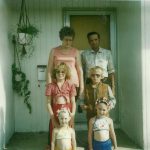 Our girls always loved to go for visits too. They got to hang out with their cousins Sheila and Pat Cole, and while they were older than our girls, they all still had a great time. The kids all played together with minimal fighting, and there was little they could do to get into trouble. We always enjoyed our visits to see Linda and Bobby and their family, and now that both Linda and Bobby are in Heaven, the memories are even more precious than they were before. Today would have been Linda’s 71st birthday. Happy birthday in Heaven, Linda. We love and miss you very much.
Our girls always loved to go for visits too. They got to hang out with their cousins Sheila and Pat Cole, and while they were older than our girls, they all still had a great time. The kids all played together with minimal fighting, and there was little they could do to get into trouble. We always enjoyed our visits to see Linda and Bobby and their family, and now that both Linda and Bobby are in Heaven, the memories are even more precious than they were before. Today would have been Linda’s 71st birthday. Happy birthday in Heaven, Linda. We love and miss you very much.
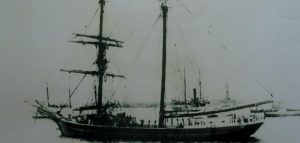 The Mary Celeste began its fateful voyage on November 7, 1872. She set sail with seven crewmen and Captain Benjamin Spooner Briggs, his wife, Sarah, and the couple’s 2-year-old daughter, Sophia. The 282 ton brigantine battled heavy weather for two weeks to reach the Azores. It was there that the ship logged its last entry at 5am on November 25, 1872. The rest of the story of the Mary Celeste remains a mystery, although the ship was found in good shape and completely sea-worthy.
The Mary Celeste began its fateful voyage on November 7, 1872. She set sail with seven crewmen and Captain Benjamin Spooner Briggs, his wife, Sarah, and the couple’s 2-year-old daughter, Sophia. The 282 ton brigantine battled heavy weather for two weeks to reach the Azores. It was there that the ship logged its last entry at 5am on November 25, 1872. The rest of the story of the Mary Celeste remains a mystery, although the ship was found in good shape and completely sea-worthy.
I find it strange to think that in the middle of the ocean, something can happen with little or no warning, that either takes the lives of people onboard a ship, or results in their disappearance. I understand mutiny, but then that does not leave a ship abandoned. So if not mutiny, how is it that the occupants of the ship did not see the other ship approaching? I know that pirates often overtook the ships, but the occupants of the ship were usually killed in a bloody battle. The people onboard did not just disappear. Nevertheless, something happened on the Mary Celeste between that final message on November 25, 1872 and December 5th, 1872, when she was spotted drifting along, in the Atlantic Ocean…empty.
The British brig Dei Gratia was about 400 miles east of the Azores on December 5, 1872, when crew members spotted a ship adrift in the choppy seas. Captain David Morehouse was shocked to discover that the unguided vessel was the Mary Celeste. It had left New York City eight days before him and should have already arrived in Genoa, Italy. He changed course to offer help. Morehouse sent a boarding party to the ship. When they went below decks, they discovered that the ship’s charts had been tossed about, and the crewmen’s belongings were still in their quarters. The ship’s only lifeboat was missing, and one of its two pumps had been disassembled. Three and a half feet of water was sloshing in the ship’s bottom, but the cargo of 1,701 barrels of industrial alcohol was largely intact. There was a six month supply of food and water…and no one to use it. So, the mystery began, and it has endured as one of the most durable mysteries in nautical history…What happened to the ten people who had sailed aboard the Mary Celeste? Over the many years since the discovery, a lack of hard evidence has only created more speculation as to what might have taken place. Theories have ranged from mutiny to pirates to sea monsters to killer waterspouts….some of which are completely ridiculous, but in the absence of evidence, people will speculate.
Arthur Conan Doyle’s 1884 short story based on the case posited a capture by a vengeful ex-slave, a 1935 movie featured Bela Lugosi as a homicidal sailor. Now, a new investigation, drawing on modern maritime technology and newly discovered documents, has pieced together the most likely scenario…which had nothing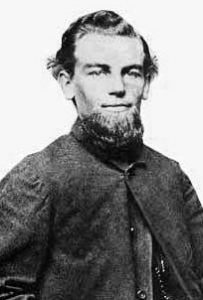 to do with Bela Lugosi. In fact, while it is unproven, it is thought that something a simple as coal dust could be the culprit. The idea is that the coal dust from a prior voyage filtered into the ships pumps, causing them to quit working. Then, it is thought that the captain, fearing that the ship would sink, ordered the passengers to abandon ship…well within sight of land at Azores. Anne MacGregor, the documentarian who launched the investigation and wrote, directed and produced The True Story of the ‘Mary Celeste,’ partly with funding from Smithsonian Networks. MacGregor learned that on its previous voyage, the Mary Celeste had carried coal and that the ship had recently been extensively refitted. Coal dust and construction debris could have fouled the ship’s pumps, which would explain the disassembled pump found on the Mary Celeste. With the pump inoperative, Briggs would not have known how much seawater was in his ship’s hull, which was too fully packed for him to measure visually. Of course, this is still speculation, because the ten people onboard were never heard from again, so the mystery continues.
to do with Bela Lugosi. In fact, while it is unproven, it is thought that something a simple as coal dust could be the culprit. The idea is that the coal dust from a prior voyage filtered into the ships pumps, causing them to quit working. Then, it is thought that the captain, fearing that the ship would sink, ordered the passengers to abandon ship…well within sight of land at Azores. Anne MacGregor, the documentarian who launched the investigation and wrote, directed and produced The True Story of the ‘Mary Celeste,’ partly with funding from Smithsonian Networks. MacGregor learned that on its previous voyage, the Mary Celeste had carried coal and that the ship had recently been extensively refitted. Coal dust and construction debris could have fouled the ship’s pumps, which would explain the disassembled pump found on the Mary Celeste. With the pump inoperative, Briggs would not have known how much seawater was in his ship’s hull, which was too fully packed for him to measure visually. Of course, this is still speculation, because the ten people onboard were never heard from again, so the mystery continues.
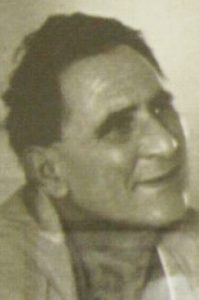 For most of the early years of human history, when a person’s heart gave out…or any other organ, for that matter, it was often the end of that person. Doctors could only do so much, and there are certain body parts that we cannot live without. Of course, these days all that has changed. What used to be considered Frankensteinish, is now a part of modern medicine, and it is saving lives every day. Of course, I don’t think an actual head transplant has ever been done successfully, but many organs are successfully transplanted every day, and every day we hear about some other organ they can transplant…I even read somewhere, and of course, this could be fiction, that they were close to being able to do a brain transplant. I have to admit that the idea of a brain transplant is beyond what I can conceive, but it’s hard to say what is possible…especially when the first heart transplant seemed impossible before December 3, 1967.
For most of the early years of human history, when a person’s heart gave out…or any other organ, for that matter, it was often the end of that person. Doctors could only do so much, and there are certain body parts that we cannot live without. Of course, these days all that has changed. What used to be considered Frankensteinish, is now a part of modern medicine, and it is saving lives every day. Of course, I don’t think an actual head transplant has ever been done successfully, but many organs are successfully transplanted every day, and every day we hear about some other organ they can transplant…I even read somewhere, and of course, this could be fiction, that they were close to being able to do a brain transplant. I have to admit that the idea of a brain transplant is beyond what I can conceive, but it’s hard to say what is possible…especially when the first heart transplant seemed impossible before December 3, 1967.
On that day, 53 year old received the first human heart transplant at Groote Schuur Hospital in Cape Town, South Africa. Washkansky was a South African grocer dying from chronic heart disease. Then, Denise Darvall, a 25 year old woman was fatally injured in a car accident. Surgeon Christiaan Barnard, who had trained at the University of Cape Town and in the United States, performed the revolutionary medical operation. The technique Barnard employed had been initially developed 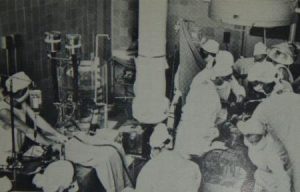 by a group of American researchers in the 1950s. American surgeon Norman Shumway achieved the first successful heart transplant, in a dog, at Stanford University in California in 1958, but prior to that time, transplants were simply a theory.
by a group of American researchers in the 1950s. American surgeon Norman Shumway achieved the first successful heart transplant, in a dog, at Stanford University in California in 1958, but prior to that time, transplants were simply a theory.
A successful heart transplant, or any transplant for that matter, does not necessarily mean a long life after the transplant…unfortunately. After Washkansky’s surgery, he was given drugs to suppress his immune system and keep his body from rejecting the heart. Those drugs worked well, in that Washkansky’s new heart had functioned normally until his death. Nevertheless, these drugs also left him susceptible to sickness, and 18 days later he died from double pneumonia. While losing him was a devastating setback, in the realm of transplants, the operation was an amazing success. Still, a successful transplant was not going to help people to survive, if the anti-rejection medications stifle the immune system and cause the patient to get sick and die 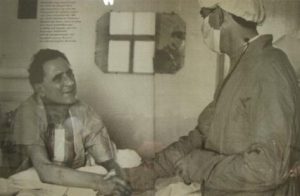 of other illnesses that would have been harmless otherwise.
of other illnesses that would have been harmless otherwise.
In the 1970s, the development of better anti-rejection drugs gave new hope to the transplantation program. Dr. Barnard continued to perform heart transplant operations, and by the late 1970s many of his patients were living up to five years with their new hearts. Successful heart transplant surgery continues to be performed today, but finding appropriate donors is extremely difficult, because the donor must be a match to the patient in blood type and other factors. All too often, the patient waiting for a transplant, dies before a viable donor can found.

